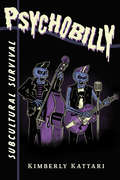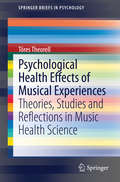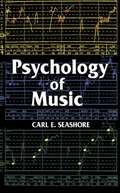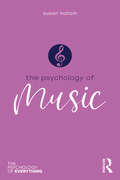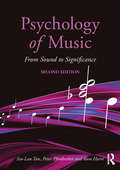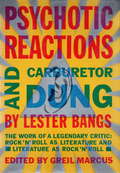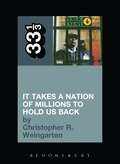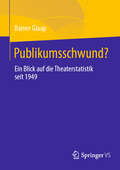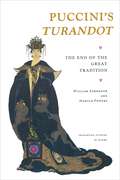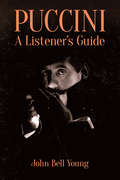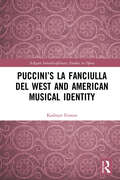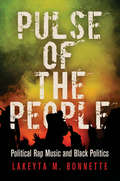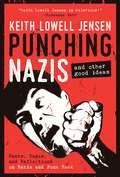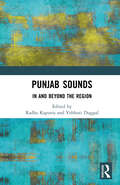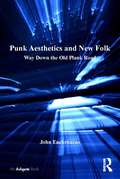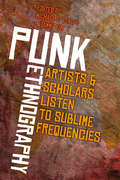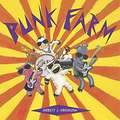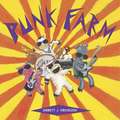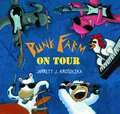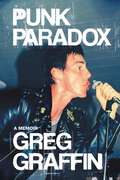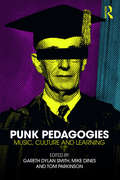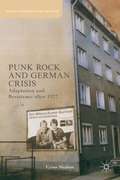- Table View
- List View
Psychoakustische Schallfeldsynthese für Musik: Raum schaffen für Komposition, Aufführung, Akustik und Wahrnehmung
by Tim ZiemerDieses Buch bietet einen umfassenden Überblick über die Räumlichkeit in der Musiktheorie, von der Abmischung und Aufführungspraxis bis hin zur Raumakustik, Psychoakustik und Tontechnik, und stellt die Ableitung, Implementierung und experimentelle Validierung eines neuartigen räumlichen Audiosystems vor. Durch die Erörterung der Physik von Musikinstrumenten und der Natur der auditiven Wahrnehmung ermöglicht das Buch den Lesern, synthetische Musikinstrumente präzise zu lokalisieren und gleichzeitig ihre klangliche Varianz und räumliche Weite zu erleben. Dieses Buch bietet interdisziplinäre Einblicke für Musikneulinge und Experten auf dem Gebiet der räumlichen Audiotechnik. Es eignet sich für alle, die sich für das Studium von Musik und Musikwissenschaft und die Anwendung von räumlichen Audiomischungen interessieren oder einen Überblick über den Stand der Technik in der angewandten Psychoakustik für räumliches Audio suchen.
Psychobilly: Subcultural Survival
by Kimberly Kattari“I got 1-2-3-4 psychobilly DNA”—Norm and the Nightmarez Call it punk rockabilly with science-fiction horror lyrics. The outsider musical genre known as psychobilly, which began in 1980s Britain, fuses punk, heavy metal, new wave, and shock rock with carnivalesque elements. The participants in this underground scene sport coffin tattoos and 1950s fashions. Bands such as The Meteors, Nekromantix, and Demented Are Go play with a wild energy and a fast tempo. Sometimes fake blood runs down a performer’s mouth. Psychobilly is ethnomusicologist Kimberly Kattari’s fascinating, decade-long study of this little-known anti-mainstream genre. She provides a history and introduces readers to the core aspects of the music as she interviews passionate performers and fans. Kattari seeks to understand how psychobilly so strongly affects—and reflects—its participants’ lives and identities so strongly. She observes that it provides not only a sense of belonging but a response to feelings and experiences of socio-economic marginalization and stigmatization. Psychobilly shows how this subculture organized around music furnishes an outlet for members to resist normative expectations and survive; they adhere to their own rules by having a good time while going through a hard time.
Psychological Health Effects of Musical Experiences
by Töres TheorellThis book is about links between music and health. It focuses on music and public health, and, in particular, the potentially positive and negative effects of listening to and making music on the health of the general population. The book starts out by discussing the protection music offers against adverse effects of stress. It then discusses social aspects of music production and listening and examines religious music within the framework of social functioning. It offers insight into the physiological and psychological effects of music listening, the biological effects of singing, and the use of music in therapeutic situations and the rearing of children. The book concludes by discussing the significance of music for musicians and their health. Although it may seem that music has only good health effects, and therefore all professional musicians should be healthy, not all music effects are positive. The book describes situations in which music has negative health effects and makes clear that there is a pronounced difference between living with music for joy and to earn one´s living from making music. In the latter situation, performance anxiety may become a factor that affects health adversely.
Psychology of Music
by Carl E. SeashoreBetween the physical world of vibration, as measured by apparatus, and the world of consciously heard music there is a third area of investigation. Our auditory apparatus and/or mind separates different instruments and tones, hears some vibrations but not others, adds tones to fill out the sound spectrum, etc. This middle ground is the province of the psychology of music, a subject about which even many physical scientists know little.This introduction, by the developer of the Seashore test of musical ability, is a thorough survey of this field, the standard book for psychologists specializing in the area, for the school, and for interested musicologists. It opens with the musical mind and with a series of chapters on music as a medium: vibrato, pitch, loudness, duration, timbre, tone, consonance, volume, and rhythm, dealing with each from the special point of view of the role of psychology. It then moves to such factors as learning, imagining, and thinking in music; the nature of musical feeling; the relative sound patterns of specific instruments and the human voice; measures of musical talent; inheritance of musical ability; primitive music; the development of musical skills; and musical aesthetics.This wealth of material is supplemented with dozens of oscillograms and other sound-pattern charts recorded from actual play and singing by Jeritza, Caruso, Paderewski, Szigeti, Rethberg, Menuhin, Martinelli, and other artists. An appendix cites two attitudes toward the evaluation of musical talent and over 200 bibliographic references.
Psychology of Music (The Psychology of Everything)
by Susan HallamHow does music affect our moods? What is the best way to develop musical skills? How does the definition of music vary between cultures? The Psychology of Music explores the important impact music has on our everyday lives, and its influence on society, groups and individual people. It demonstrates how music can benefit our intellectual functioning, and health and well-being, and examines musical ability as both a gift and something that can be developed through learning and practice. Music can enhance our understanding of humanity and modern life and The Psychology of Music shows us the significance of music, and the power it can have over our behaviour.
Psychology of Music: From Sound to Significance
by Rom Harré Siu-Lan Tan Peter PfordresherIn Psychology of Music: From Sound to Significance (2nd edition), the authors consider music on a broad scale, from its beginning as an acoustical signal to its different manifestations across cultures. In their second edition, the authors apply the same richness of depth and scope that was a hallmark of the first edition of this text. In addition, having laid out the topography of the field in the original book, the second edition puts greater emphasis on linking academic learning to real-world contexts, and on including compelling topics that appeal to students’ natural curiosity. Chapters have been updated with approximately 500 new citations to reflect advances in the field. The organization of the book remains the same as the first edition, while chapters have been updated and often expanded with new topics. 'Part I: Foundations' explores the acoustics of sound, the auditory system, and responses to music in the brain. 'Part II: The Perception and Cognition of Music' focuses on how we process pitch, melody, meter, rhythm, and musical structure. 'Part III: Development, Learning, and Performance' describes how musical capacities and skills unfold, beginning before birth and extending to the advanced and expert musician. And finally, 'Part IV: The Meaning and Significance of Music' explores social, emotional, philosophical and cultural dimensions of music and meaning. This book will be invaluable to undergraduates and postgraduate students in psychology and music, and will appeal to anyone who is interested in the vital and expanding field of psychology of music.
Psychotic Reactions and Carburetor Dung
by Lester BangsVintage presents the paperback edition of the wild and brilliant writings of Lester Bangs--the most outrageous and popular rock critic of the 1970s--edited and with an introduction by the reigning dean of rack critics, Greil Marcus. Advertising in Rolling Stone and other major publications.
Public Enemy's It Takes a Nation of Millions to Hold Us Back (33 1/3 Ser. #71)
by Christopher R. WeingartenChristopher R. Weingarten provides a thrilling account of how the Bomb Squad produced such a singular-sounding record: engineering, sampling, scratching, constructing, deconstructing, reconstructing—even occasionally stomping on vinyl that sounded too clean. Using production techniques that have never been duplicated, the Bomb Squad plundered and reconfigured their own compositions to make frenetic splatter collages; they played samples by hand together in a room like a rock band to create a “not quite right” tension; they hand-picked their samples from only the ugliest squawks and sirens.
Publikumsschwund?: Ein Blick auf die Theaterstatistik seit 1949
by Rainer GlaapDurch den teils massiven Publikumsschwund nach der Pandemie stellt sich die Frage, ob diese als Brandbeschleuniger gewirkt hat für bereits vorhandene Trends. Der Autor geht dem nach anhand der Besuchszahlen bis zur letzten vollständigen vorpandemischen Spielzeit 2018/19. Er zeigt historische Zeitreihen zu Sparten- und Personalentwicklung, Vertriebskanälen und den Einnahmen. Die Theaterstatistik des Bühnenvereins dient vielen Entscheidungsträgern als Grundlage für z.B. kulturpolitische Steuerungen, obwohl sie nicht die komplette deutsche Theaterlandschaft abbildet. Deshalb beleuchtet der Autor weitere Anbieter. Da die Theaterstatistik große kulturpolitische Bedeutung hat, gibt es zum Schluss einige Vorschläge für die Zukunft.
Puccini Without Excuses: A Refreshing Reassessment of the World's Most Popular Composer
by William BergerPuccini is the most beloved composer of opera in the world: one quarter of all opera performances in the U. S. are of his operas, his music pervades movie soundtracks, and his plots have infiltrated our popular culture. But, although Puccini’s art still captivates audiences and the popularity of such works asTosca, La Boh?me,andMadama Butterflyhas never waned, he has long been a victim of critical snobbery and cultural marginalization. In this witty and informative guide for beginners and fans alike, William Berger sets the record straight, reclaiming Puccini as a serious artist. Combining his trademark irreverent humor with passionate enthusiasm, Berger strikes just the right balance of introductory information and thought-provoking analysis. He includes a biography, discussions of each opera, a glossary, fun facts and anecdotes, and above all keen insight into Puccini’s enduring power. For anyone who loves Puccini and for anyone who just wonders what all the fuss is about,Puccini Without Excusesis funny, challenging, and always a pleasure to read. INCLUDES: _ Why Puccini’s art and its message of hope is crucial to our world today _ How Anglo audiences often miss the mythic significance of his operas _ The use of his music as shorthand in films, fromA Room with a ViewtoFatal Attraction _ A scene-by scene analysis of each opera _ A guide to the wealth of available recordings, books, and videos
Puccini Without Excuses: A Refreshing Reassessment of the World's Most Popular Composer
by William BergerPuccini is the most beloved composer of opera in the world: one quarter of all opera performances in the U.S. are of his operas, his music pervades movie soundtracks, and his plots have infiltrated our popular culture. But, although Puccini’s art still captivates audiences and the popularity of such works as Tosca, La Boh?me, and Madama Butterfly has never waned, he has long been a victim of critical snobbery and cultural marginalization.In this witty and informative guide for beginners and fans alike, William Berger sets the record straight, reclaiming Puccini as a serious artist. Combining his trademark irreverent humor with passionate enthusiasm, Berger strikes just the right balance of introductory information and thought-provoking analysis. He includes a biography, discussions of each opera, a glossary, fun facts and anecdotes, and above all keen insight into Puccini’s enduring power. For anyone who loves Puccini and for anyone who just wonders what all the fuss is about, Puccini Without Excuses is funny, challenging, and always a pleasure to read. INCLUDES:_ Why Puccini’s art and its message of hope is crucial to our world today_ How Anglo audiences often miss the mythic significance of his operas_ The use of his music as shorthand in films, from A Room with a View to Fatal Attraction_ A scene-by scene analysis of each opera_ A guide to the wealth of available recordings, books, and videos
Puccini's Turandot: The End of the Great Tradition (Princeton Studies in Opera #30)
by William Ashbrook Harold PowersUnfinished at Puccini's death in 1924, Turandot was not only his most ambitious work, but it became the last Italian opera to enter the international repertory. In this colorful study two renowned music scholars demonstrate that this work, despite the modern climate in which it was written, was a fitting finale for the centuries-old Great Tradition of Italian opera. Here they provide concrete instances of how a listener might encounter the dramatic and musical structures of Turandot in light of the Italian melodramma, and firmly establish Puccini's last work within the tradition of Rossini, Bellini, Donizetti, and Verdi. In a summary of the sounds, sights, and symbolism of Turandot, the authors touch on earlier treatments of the subject, outline the conception, birth, and reception of the work, and analyze its coordinated dramatic and musical design. Showing how the evolution of the libretto documents Puccini's reversion to large musical forms typical of the Great Tradition in the late nineteenth century, they give particular attention to his use of contrasting Romantic, modernist, and two kinds of orientalist coloration in the general musical structure. They suggest that Puccini's inability to complete the opera resulted mainly from inadequate dramatic buildup for Turandot's last-minute change of heart combined with an overly successful treatment of the secondary character.
Puccini: A Listener's Guide (Unlocking The Masters Ser.)
by John Bell YoungGiacomo Puccini (1858-1924) began his career at the end of the Romantic period and his death signaled the end of the last major age of Italian opera. During his lifetime and in posterity, the composer's popularity surpassed that of his peers, and three of his works -- La bohéme, Tosca, and Madama Butterfly -- rank among the twenty-first century's ten most-performed operas. With their enchanting melodies, exotic subjects, and realistic plots, Puccini's operas continue to speak to the minds and hearts of listeners. This comprehensive exploration of Puccini's most beloved operas presents concise and entertaining overviews of the composer's works. In addition to exploring the poignant stories that inspired the operas, the guide elaborates on their musical and dramatic content. Part musical analysis and part interpretation, this book is above all a personal appreciation. In addition to offering an ideal companion for opera devotees, the accessible treatment forms an excellent introduction for novices.
Puccini’s La fanciulla del West and American Musical Identity (Ashgate Interdisciplinary Studies in Opera)
by Kathryn M. FentonOn 10 December 1910, Giacomo Puccini’s seventh opera, La fanciulla del West, had its premiere before a sold-out audience at New York City’s Metropolitan Opera House. The performance was the Metropolitan Opera Company’s first world premiere by any composer. By all accounts, the premiere was an unambiguous success and the event itself recognized as a major moment in New York cultural history. The initial public opinion matched Puccini’s own evaluation of his opera. He called it "the best he had ever written" and expected it to become as popular as La Bohème. Yet the music reviews tell a different story. Marked by ambivalence, the reviews expose the New York City critics’ struggle to reconcile the opera they expected to see with the one they actually saw, and the opera itself became embroiled in controversy over the essence of musical Americanness and the nativist perception that a uniquely American national opera tradition continued to elude both American- and foreign-born opera composers. This book seeks to account for the differences between Puccini’s own assessments of the opera and those of its first audience. Offering transcriptions of the central reviews and of letters unavailable elsewhere, the book provides a historically informed understanding of La fanciulla del West and the reception of this European work as it intersected with both opera production and consumption in the United States and with the process of American musical identity formation during the very period that Americans actively sought to eradicate European cultural influences. As such, it offers a window into the development of nativism and "cosmopolitan nationalism" in New York City’s musical life during the first decade of the twentieth century.
Pulse of the People
by Lakeyta M. BonnetteHip-Hop music encompasses an extraordinarily diverse range of approaches to politics. Some rap and Hip-Hop artists engage directly with elections and social justice organizations; others may use their platform to call out discrimination, poverty, sexism, racism, police brutality, and other social ills. In Pulse of the People, Lakeyta M. Bonnette illustrates the ways rap music serves as a vehicle for the expression and advancement of the political thoughts of the urban Black community, a population frequently marginalized within American society and alienated from electoral politics. Pulse of the People lays a foundation for the study of political rap music and public opinion research and demonstrates ways in which political attitudes asserted in the music have been transformed into direct action and behavior of constituents. Bonnette examines the history of rap music and its relationship to and extension from other cultural and political vehicles within Black America, presenting criteria for identifying the specific subgenre of music that is political rap. She complements the statistics of rap music exposure with lyrical analysis of rap songs that espouse Black Nationalist and Black Feminist attitudes. Touching on a number of critical moments in American racial politics--including the 2008 and 2012 elections and the cases of the Jena 6, Troy Davis, and Trayvon Martin--Pulse of the People makes a compelling case for the influence of rap music in the political arena and greatly expands our understanding of the ways political ideologies and public opinion are formed.
Punching Nazis: And Other Good Ideas
by Keith Lowell JensenKeith Lowell Jensen thinks you should punch Nazis. In this collection of essays, stories, interviews, and rants, he tells us why. Jensen grew up and into the Sacramento punk music scene in the late eighties and early nineties, where weirdos, LGBTQ folk, feminists, and allies strived to carve out safe community spaces. This scene also attracted a different kind of outsider--white supremacists and Nazi skinheads—making for a politically charged and complicated landscape. In Punching Nazis, he reflects on his experiences with these racist fringe groups that infiltrated the progressive scene that gave rise to bands like Green Day. From unwittingly driving around in a lowrider with a gang called “The Suicidals,” to a night doing stand-up with a clown with an unwanted Swastika tattoo, Jensen brings his brand of subtle, sincere comedy to reflect on the complicated relationship that punk music has with racist skinheads and what we should do about it. In recent times, Americans are surprised to find groups like the Klan, and more recently the "Racial Realists" and the "Alt-Right," are still prominent, and now as they grow increasingly emboldened, it’s intriguing and valuable to hear tales of those who, through the love of punk rock music, have a history of dealing with racist fringe groups.
Punjab Sounds: In and Beyond the Region
by Radha Kapuria Vebhuti DuggalPunjab Sounds nuances our understanding of the region's imbrications with sound. It argues that rather than being territorially bounded, the region only emerges in ‘regioning’, i.e., in words, gestures, objects, and techniques that do the region. Regioning sound reveals the relationship between sound and the region in three interlinked ways: in doing, knowing, and feeling the region through sound.The volume covers several musical genres of the Punjab region, including within its geographical remit the Punjabi diaspora and east and west Punjab. It also provides new understandings of the role that ephemeral cultural expressions, especially music and sound, play in the formulation of Punjabi identity. Featuring contributions from scholars across North America, South Asia, Europe, and the UK, it brings together diverse perspectives. The chapters use a range of different methods, ranging from computational analysis and ethnography to close textual analysis, demonstrating some of the ways in which research on music and sound can be carried out.The chapters will be relevant for anyone working on Punjab’s music, including the Punjabi diaspora, music, and sound in the Global South. Moreover, it will be useful for undergraduate and postgraduate students in the following areas: ethnomusicology, cultural studies, film studies, music studies, South Asian studies, Punjab studies, history, and sound studies, among others.
Punk Aesthetics and New Folk: Way Down the Old Plank Road (Ashgate Popular and Folk Music Series)
by John EncarnacaoJoanna Newsom, Will Oldham (a.k.a. 'Bonnie Prince Billy'), and Devendra Banhart are perhaps the best known of a generation of independent artists who use elements of folk music in contexts that are far from traditional. These (and other) so called ’new folk’ artists challenge our notions of 'finished product' through their recordings, intrinsically guided by practices and rhetoric inherited from punk. This book traces a fractured trajectory that includes Harry Smith's Anthology of American Folk Music, Bob Dylan, psych-folk of the sixties (from Vashti Bunyan to John Fahey), lo-fi and outsider recordings (from Captain Beefheart and The Residents to Jandek, Daniel Johnston and Smog), and recent experimental folk (Animal Collective, Six Organs of Admittance, Charalambides) to contextualise the first substantial consideration of new folk. In the process, Encarnacao reviews the literature on folk and punk to argue that tropes of authenticity, though constructions, carry considerable power in the creation and reception of recorded works. New approaches to music require new analytical tools, and through the analysis of some 50 albums, Encarnacao introduces the categories of labyrinth, immersive and montage forms. This book makes a compelling argument for a reconsideration of popular music history that highlights the eternal compulsion for spontaneous, imperfect and performative recorded artefacts.
Punk Ethnography: Artists & Scholars Listen to Sublime Frequencies
by Michael E. Veal E. Tammy KimThis ground-breaking case study examines record production as ethnographic work. Since its founding in 2003, Seattle-based record label Sublime Frequencies has produced world music recordings that have been received as radical, sometimes problematic critiques of the practices of sound ethnography. Founded by punk rocker brothers Alan and Richard Bishop, along with filmmaker Hisham Mayet, the label's releases encompass collagist sound travelogues; individual artist compilations; national, regional and genre surveys; and DVDs--all designed in a distinctive graphic style recalling the DIY aesthetic of punk and indie rock. Sublime Frequencies' producers position themselves as heirs to canonical ethnographic labels such as Folkways, Nonesuch, and Musique du Monde, but their aesthetic and philosophical roots in punk, indie rock, and experimental music effectively distinguish their work from more conventional ethnographic norms. Situated at the intersection of ethnomusicology, sound studies, cultural anthropology, and popular music studies, the essays in this volume explore the issues surrounding the label--including appropriation and intellectual property--while providing critical commentary and charting the impact of the label through listener interviews.
Punk Farm
by Jarrett J. KrosoczkaAfter a long day of work, Farmer Joe goes home to bed. But meanwhile, back at the barn . . . Cow sets up her drums. Pig plugs in his amp. Goat tunes his bass. Chicken sets up her keyboards. And Sheep checks the microphone. They are Punk Farm and tonight they're ready to ROCK! With adorable farm animals - and a surprise tribute to Old MacDonald - this rollicking tale is sure to have kids cheering--and singing--along. From the Hardcover edition.
Punk Farm (Punk Farm Books)
by Jarrett J. KrosoczkaAfter a long day of work, Farmer Joe goes home to bed. But meanwhile, back at the barn . . .Cow sets up her drums.Pig plugs in his amp.Goat tunes his bass.Chicken sets up her keyboards.And Sheep checks the microphone.They are Punk Farm and tonight they're ready to ROCK! With adorable farm animals - and a surprise tribute to Old MacDonald - this rollicking tale is sure to have kids cheering--and singing--along.From the Hardcover edition.
Punk Farm on Tour (Punk Farm Books)
by Jarrett J. KrosoczkaFARMER JOE IS heading off to a Tractor Society Conference in Reno. But meanwhile, back at the farm . . .. . . Cow, Sheep, Pig, Goat, and Chicken are getting ready to rock across the U.S.A. as they set out on a Punk Farm tour! Only, their beat-up old tour van is threatening to ruin their plans. Can the wheels on the van go round and round all the way from Maine to Colorado?This rollicking sequel to Punk Farm will have kids cheering along as their favorite rock star farm animals take the nation by storm!From the Hardcover edition.
Punk Paradox: A Memoir
by Greg GraffinFrom the legendary singer-songwriter of Bad Religion comes a historical memoir and cultural criticism of punk rock&’s evolution. Greg Graffin is the lead vocalist and songwriter of Bad Religion, recently described as &“America's most significant punk band.&” Since its inception in Los Angeles in 1980, Bad Religion has produced 18 studio albums, become a long-running global touring powerhouse, and has established a durable legacy as one of the most influential punk rock bands of all time. Punk Paradox is Graffin's life narrative before and during L.A. punk's early years, detailing his observations on the genre's explosive growth and his band's steady rise in importance. The book begins by exploring Graffin&’s Midwestern roots and his life-changing move to Southern California in the mid-&’70s. Swept up into the burgeoning punk scene in the exhilarating and often-violent streets of Los Angeles, Graffin and his friends formed Bad Religion, built a fanbase, and became a touring institution. All these activities took place in parallel with Graffin's never ceasing quest for intellectual enlightenment. Despite the demands of global tours, recording sessions, and dedication to songwriting, the author also balanced a budding academic career. In so doing, he managed to reconcile an improbable double-life as an iconic punk rock front man and University Lecturer in evolution. Graffin&’s unique experiences mirror the paradoxical elements that define the punk genre—the pop influence, the quest for society&’s betterment, music&’s unifying power—all of which are prime ingredients in its surprising endurance. Fittingly, this book argues against the traditional narrative of the popular perception of punk. As Bad Religion changed from year to year, the spirit of punk—and its sonic significance—lived on while Graffin was ever willing to challenge convention, debunk mythology, and liberate listeners from the chains of indoctrination. As insightful as it is exciting, this thought-provoking memoir provides both a fly on the wall history of the punk scene and astute commentary on its endurance and evolution.
Punk Pedagogies: Music, Culture and Learning
by Gareth Dylan Smith Mike Dines Tom ParkinsonPunk Pedagogies: Music, Culture and Learning brings together a collection of international authors to explore the possibilities, practices and implications that emerge from the union of punk and pedagogy. The punk ethos—a notoriously evasive and multifaceted beast—offers unique applications in music education and beyond, and this volume presents a breadth of interdisciplinary perspectives to challenge current thinking on how, why and where the subculture influences teaching and learning. As (punk) educators and artists, contributing authors grapple with punk’s historicity, its pervasiveness, its (dis)functionality and its messiness, making Punk Pedagogies relevant and motivating to both instructors and students with proven pedagogical practices.
Punk Rock And German Crisis
by Cyrus Shahan1977 is usually associated with West German terrorism, but it witnessed another cultural watershed: punk music. A new reckoning with the legacy of political and aesthetic spaces, this book argues the centrality of punk music for understanding crises of state and terrorist violence, American racism and German fascism, and aesthetic production.

